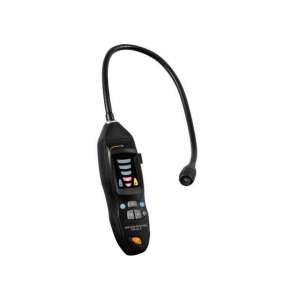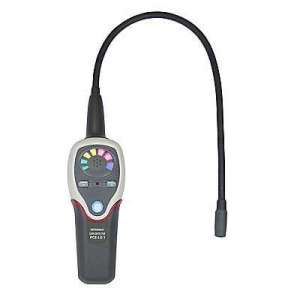Gas detector
The gas detector is used to locate leaks, water routes or gas leaks. Leaks are those holes in products or technical systems that cause an unwanted entry or exit of solid, liquid or gaseous matter. Since leaks can damage complete technical systems, the gas detector is the ideal apparatus for the prompt identification of such defects and thus prevent further damage resulting from them.
The impermeability in the technical sense of a system can be defined by the so-called leakage quota (in mbar x l/s) and the diameter of the perforation. In case of drilling diameters of 100 μm, a faucet, for example, begins to drip. In case of hole diameters in the two-digit nanometric range and leakage quotas of 10-7 mbar x l/s, we speak of gas-tight systems (1 cm3 of gas loss in 100 days). Only from drilling diameters of one nanometer, a system is defined as technically absolute watertight (1 cm3 of gas loss in 300 years).
The gas detector can locate leaks of different sizes and characteristics. It differentiates, for example, between hole leaks (visible), molecular leaks (pores in the polycrystalline network) or valve leaks (leaks with a certain direction of flow).
In certain ducts, the presence of a leak can cause serious damage. For this reason, the necessary checks must be carried out with an appropriate pressure measuring instrument, in order to improve protection against failures and comply with legal provisions.
Among the important measurements you can perform with a gas detector are the following:
· the tightness test
· the endurance test
· the leak test.
Pressure measurement and leak finding
If it detects a leak, the leak estimation instrument will allow you to perform an accurate and fast control measurement. To do this, the gas detector has an integrated pump. It quickly detects gases in ambient air, such as methane and propane, and determines where the gas leak is located.
Gas detectors make it possible to safely determine the existence of leaks in natural gas pipelines. This is particularly important when microcracks or aged joints are expected.
Using the gas detector will provide you with accurate information that will help you find the location of the leak and determine the leakage flow.
Fields of application and accessories for the leak detector
Innovative instruments for pressure measurement and leak estimation make it significantly easier to check gas and water ducts comfortably and safely. The refrigerant leak detector allows the search for leaks in refrigeration systems to be carried out. This instrument quickly detects known refrigerants and also finds the smallest leaks. Compressed air leak detectors work with the corresponding high-pressure probe. In our Marketplace you can find the most reliable and safe detectors on the market,
Detector de fugas de gas PCE-GA 10

Product Data Sheet:
Price:
€226.15 (inc. VAT)Detector de fugas PCE-LD 1

Product Data Sheet:
Price:
€266.08 (inc. VAT)



